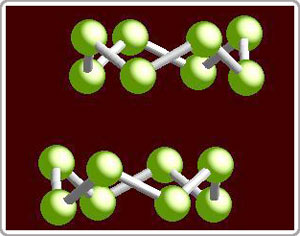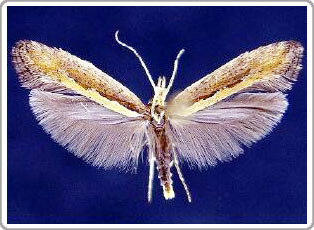A new butterfly can resist plants that contain Selenium
In a study recently released on November 21 in Current Biology, Professor Elizabeth Pilon-Smits of the University of Colorado and colleagues at the University of California, Berkely reported on a self-defense ability of a number of plants by accumulating a sufficient amount of toxin to prevent some parasitic insects, and such adaptation is capable of repeating the process of circulating food (big children eat her) like the way of prey and how the parasite changes to adapt to this high level of toxin.
 Selenium, which has similar properties to sulfur and is an essential root factor for many organisms (Photo: webelements) Some plants ' accumulate too much ' amount of selenium even up to 1% of the tree's anhydrous weight . Selenium , which has similar properties to sulfur and is an essential root factor for many organisms, is characterized by a high toxicity. Besides these functions, the tendency to " accumulate too much " of selenium in some plants is an interesting phenomenon that is less well known. And the so-called 'resistance factor hypothesis' poses the problem that 'too much accumulation' factors can serve to resist against certain types of herbivores and and Other realities.
Selenium, which has similar properties to sulfur and is an essential root factor for many organisms (Photo: webelements) Some plants ' accumulate too much ' amount of selenium even up to 1% of the tree's anhydrous weight . Selenium , which has similar properties to sulfur and is an essential root factor for many organisms, is characterized by a high toxicity. Besides these functions, the tendency to " accumulate too much " of selenium in some plants is an interesting phenomenon that is less well known. And the so-called 'resistance factor hypothesis' poses the problem that 'too much accumulation' factors can serve to resist against certain types of herbivores and and Other realities.
In a recent study, scientists have shown that plants that accumulate too much selenium (Stanleya pinnata) help protect it from plant-eating moths by making them lose their appetite and causing poisoning . However, the researchers also pointed out that in the natural habitat of plants, a new type of moth has been discovered ' Plutella xylostella ' that is resistant to this toxin. The fact that this butterfly can live on plants that contain high levels of selenium, and is different from some, is not hampered by egg laying and food on this plant. Moreover, the researchers also found that a selenium-resistant wasp (Diadegma insulare) was parasitized on the Plutella xylostella butterfly.
Chemical analysis showed that selenium-resistant butterflies and the parasites on it all accumulated selenium in the form of Methylselenocysteine (SeMSC), the same type with selenium-rich plants, whereas the selenium-sensitive butterflies also accumulated. a similar form of selenocysteine. And the second form is very toxic due to its ability to combine into protein.

Plutella xylostella moth
(Photo: mothphotographersgroup)
The scientists also outlined the evolution of selenium resistance in the Plutella xylostella moth. And the final conclusion is that although ' too much accumulation ' of selenium can help protect some plants from grass-eating invertebrates, it also provides the source of evolution of herbivores. only resistant to selenium, thus, leading to an entrance for selenium in the local ecosystem, a path by accumulating too much selenium can extend the range of parts of the circulatory process. foods.
The researchers point out a broader context, which is the findings that can suggest a number of ways to accumulate selenium for application in agriculture and ecology. Applying selenium to crops can be a very effective way to prevent herbivores and improve crop yields, and if used well can even increase productivity. Furthermore, the Plutella xylostella moth can be used for biological control of plants containing selenium, sometimes poisoning poultry. In addition, selenium-rich plants are also useful for reducing and dispersing selenium in contaminated water and soil. The researchers also note that these applications may affect the ecosystem, due to the rapid evolution of selenium-resistant insects.
Researchers include John L. Freeman, Colin F. Quinn, and Elizabeth AH Pilon-Smits of Colorado State University in Fort Collins, CO;Matthew A. Marcus and Sirine Fakra of the Lawrence Berkeley Research Institute in Berkeley, CA.This work is supported by the National Science Foundation No. IOB-0444471 EAHP-S, Office of Science, and Energy Science, branch of material science of the US Department of Energy.
- Do you know where the butterfly's ear is?
- Butterflies disguising themselves as tigers threaten enemies terribly
- 'Giant butterfly' was discovered in Malaysia
- Selenium can fight HIV?
- Butterfly Emperor faces the threat from humans
- Discovering extremely rare butterflies
- Huge butterfly
- Fragile like butterfly wings, what will their fate be when the rain comes?
- Butterflies find drugs to cure diseases
- The moment of the butterfly worm is rare
- The prospect of color changes like butterfly wings
- Germany successfully created the butterfly-like robot
 Why do potatoes have eyes?
Why do potatoes have eyes? 'Tragedy' the world's largest carnivorous life: Death becomes ... public toilet
'Tragedy' the world's largest carnivorous life: Death becomes ... public toilet Tomatoes were once considered 'poisonous' for 200 years
Tomatoes were once considered 'poisonous' for 200 years Detecting microscopic parasites on human face
Detecting microscopic parasites on human face